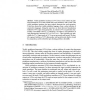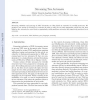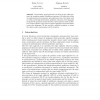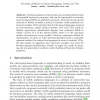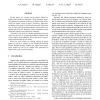CAV
2012
Springer
12 years 8 months ago
2012
Springer
Nested-word automata (NWAs) are a language formalism that helps bridge the gap between finite-state automata and pushdown automata. NWAs can express some context-free properties, ...
MFCS
2010
Springer
14 years 4 months ago
2010
Springer
Abstract. Visibly pushdown transducers (VPTs) form a strict subclass of pushdown transducers (PTs) that extends finite state transducers with a stack. Like visibly pushdown automa...
IPL
2008
14 years 6 months ago
2008
Streaming validation and querying of XML documents are often based on automata for tree-like structures. We propose a new notion of streaming tree automata in order to unify the t...
DLT
2007
14 years 7 months ago
2007
Visibly Pushdown Automata (VPA) are a special case of pushdown machines where the stack operations are driven by the input. In this paper, we consider VPA with two stacks, namely 2...
CSR
2008
Springer
14 years 7 months ago
2008
Springer
Abstract. Deterministic graph grammars are finite devices which generate the transition graphs of pushdown automata. We define the notion of synchronization by grammars, generalizi...
CSR
2008
Springer
14 years 7 months ago
2008
Springer
Abstract. While visibly pushdown languages properly generalise regular languages and are properly contained in deterministic context-free languages, the complexity of their members...
CONCUR
2006
Springer
14 years 9 months ago
2006
Springer
Boolean programs with recursion are convenient abstractions of sequential imperative programs, and can be represented as recursive state machines (RSMs) or pushdown automata. Motiv...
SIGCSE
1999
ACM
14 years 10 months ago
1999
ACM
An automata theory course can be taught in an interactive, hands-on manner using a computer. At Duke we have been using the software tool JFLAP to provide interaction and feedback...
FSTTCS
2001
Springer
14 years 10 months ago
2001
Springer
Abstract. Regular Model-Checking (RMC) is a technique for the formal verification of infinite state systems based on the theory of regular languages. In the paper “Beyond Regul...
LICS
2008
IEEE
15 years 12 days ago
2008
IEEE
In this paper we consider parity games defined by higher-order pushdown automata. These automata generalise pushdown automata by the use of higher-order stacks, which are nested ...

